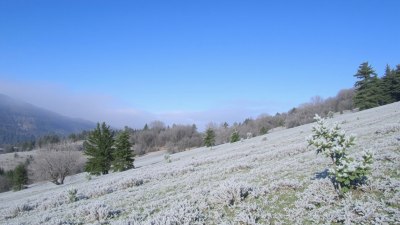How Sunspots Affect Earth’s Storms and Climate
Explore the relationship between sunspots and their influence on Earth's climate and storm patterns.

Sunspots, those dark patches that appear on the surface of the sun, have intrigued scientists and astronomers for centuries. While they may look small and insignificant from our perspective, these phenomena are actually critical indicators of solar activity, which can have profound effects on Earth’s climate and weather systems. Understanding how sunspots influence storms and climate is essential not only for meteorology but also for understanding the overall health of our planet.
Sunspots are areas on the sun where magnetic fields are particularly strong. They are cooler than their surrounding areas, leading to the darker appearance. Typically, sunspots form in cycles averaging about 11 years, known as the solar cycle. During periods of high sunspot activity, solar radiation increases, and this can impact Earth's atmosphere and climate.
The Solar Cycle and Its Impacts
The solar cycle includes phases of high sunspot numbers (solar maximum) and low sunspot numbers (solar minimum). During a solar maximum, the increase in sunspots correlates with higher solar output, which can influence Earth’s climate systems. Studies have shown that increased solar activity can lead to warmer global temperatures. Conversely, during a solar minimum, such as the Maunder Minimum from about 1645 to 1715, a significant drop in solar activity led to cooler temperatures, which had social and economic impacts, particularly in agriculture.
One key way sunspots impact Earth’s weather is through their effect on the ionosphere, a part of the atmosphere that is ionized by solar and cosmic radiation. Changes in solar activity can alter the density and composition of the ionosphere, which in turn can affect weather patterns. For example, altered jet streams and wind patterns can lead to either droughts or increased precipitation, significantly impacting storm development.
Sunspots and Storm Formation
Studies suggest that periods of high sunspot activity can correlate with increased storm frequency and intensity. For instance, higher numbers of sunspots may lead to enhanced El Niño and La Niña phenomena, which are known to cause irregular weather patterns globally. The climatic shifts brought about by these ocean temperature changes can lead to more extreme weather events such as hurricanes, thunderstorms, and heavy rainfall in various regions.
Research indicates that the solar wind, which stream of charged particles emitted by the sun, is influenced by sunspots. During times of elevated sunspot activity, the solar wind can become more turbulent. These changes can affect the Earth’s magnetic field, leading to geomagnetic storms, which may disrupt communication systems and power grids. Additionally, these geomagnetic events may also foster a more energetic environment for storm development, particularly in regions prone to severe weather.
Connection to Climate Change
While the correlation between sunspots and climate changes is significant, it is essential to understand this interaction in the context of climate change. Modern anthropogenic effects, primarily due to greenhouse gas emissions, have a much more pronounced impact on climate than solar activity. For instance, today’s temperature rise is largely attributed to human activity, including the combustion of fossil fuels and deforestation. However, some scientists argue that sunspot activity should not be dismissed entirely; ongoing research seeks to clarify the role of solar cycles in climate models.
Sunspots have been studied alongside other natural climate influences, such as volcanic activity and ocean currents, in relation to their collective impact on Earth's climate. For example, a significant volcanic eruption can inject large quantities of ash and sulfur dioxide into the atmosphere, leading to temporary cooling. These natural factors must be accurately modeled to improve predictions of future climate patterns.
Future of Solar Research
As technology evolves, our ability to observe and understand sunspots and solar influence improves. New satellite missions aim to capture and measure solar emissions more accurately, giving scientists better tools to predict how sunspots will impact weather and climate. The Solar Dynamics Observatory and upcoming projects will continue to advance our understanding of sunspots, the solar activity they represent, and how this activity resonates with Earth’s climate and storm occurrence.
Public awareness of the connection between sunspots, storms, and climate may influence policy concerning climate change adaptation and mitigation. By recognizing that solar activity plays a role—albeit one affecting a backdrop dominated by human influence—greater emphasis may be placed on developing resilient infrastructure and response strategies to cope with the wider impacts of climate change.
Sunspots in the Historical Context
Historically, the study of sunspots can be traced back to the invention of the telescope in the 17th century. Galileo Galilei and other early astronomers made the first observations of sunspots, leading to a deeper exploration of solar phenomena. The Maunder Minimum mentioned earlier is one of the most investigated periods in climate science, illustrating how changes in solar activity can influence terrestrial temperatures. Additionally, historical records and anecdotal evidence provide insight into how changes in sunspot activity may have affected climate and cultures around the world.
The connection between sunspot activity and historical climatic events is evident in the fluctuations experienced on Earth. This knowledge highlights the importance of long-term records and provides a framework for understanding how fluctuations in solar activity can have wide-reaching implications beyond mere weather patterns.
Sunspots are more than just beautiful astronomical phenomena; they are indicators of solar activity that can significantly impact Earth’s storms and climate. With ongoing research, scientists are continuously working to better understand these complex interactions and their relevance in the face of modern climate change. As we advance our knowledge, it is crucial to integrate findings about sunspot activity into broader climatic models to enhance our predictions and responses to the planet’s challenging climate future. The balance between solar influences and human-induced climate change remains a complex reality, yet understanding the nuances of these factors is vital for the future of our environment.











